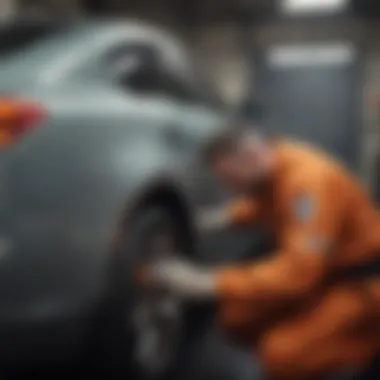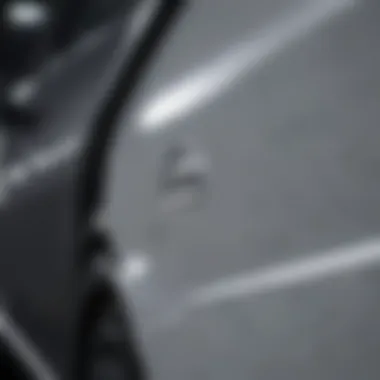Effective Methods for Removing Dents from Car Doors


Intro
Dents in car doors affect the aesthetics and value of a vehicle. Thus, understanding different methods for effectively removing these imperfections is crucial for car owners and enthusiasts alike. The process can range from simple DIY techniques to more advanced professional services. This guide aims track the paths to dent removal, ensuring practitioners are well-informed about methods that suit their distinct situations.
In-Depth Car Reviews
While the focus of this article is on dent removal, it is useful to consider the affected car’s model and specifications that could guide repairs.
Overview of the Vehicle
Each vehicle has unique considerations when handling body damage. For instance, smoother paint finishes are easier to repair compared to textured ones. Knowledge of specific vehicle models empowers the owner to choose the most effective dent removal techniques.
Key Specifications
Understanding a vehicle’s material and structure is vital. The material of the door, such as aluminum or steel, determines which tools and techniques are suitable. Important specifications include:
- Material type (steel vs aluminum)
- Door thickness
- Paint type (base coat, clear coat)
Performance Analysis
Some models offer better durability against dents due to their construction. Understanding whether a vehicle’s performance reflects practicality or style can highlight its resistance against damages like dents.
Interior and Exterior Design
The architecture of a car influences dent accessibility. Models with pronounced curves may make certain methods more complex. Evaluating design elements can lead to better handling of damages in selective areas.
Safety Ratings and Features
With varying design specifications affecting repair processes, keeping track of a vehicle’s safety ratings is important. Post-repair integrity may change, and ensuring that repairs do not compromise passenger safety is paramount.
Car Maintenance Tips
Effective dent removal starts with regualar vehicle maintenance. Following a strategic maintenance plan equips an owner to better respond to any origination of dents.
Regular Maintenance Schedule
Adhering to a maintenance schedule can lower the chances of dents occurring.
DIY Tips and Tricks
Certain effective methods for dent removal do not require extensive tools or experience:
- Boiling Water Method: Pour boiling water over the dented area to soften material. Using pressure from behind, the dent can often self-correct.
- Hair Dryer and Aluminum Foil Method: Utilize a hair dryer to heat the area then quickly apply aluminum foil and ice to create movement.
Common Problems and Solutions
Quick fixes often lead to miscalculations that may cause damage. Always approach with care to assess how existing conditions may alter repair efficiency:
- Check for paint cracks
- Look for underlying frame damage
Importance of Professional Maintenance
Not every dent can be fixed with DIY measures. Specific damages require experience and expertise. Duct tape, hot glue, and various hooks can be used methodically but may not yield fantastic results for comprehensive dents.
Seasonal Maintenance Practices
Fluctuating temperature promotes compliance in materials, making dent removal ideal in warmer seasons. It's advantageous to strategize repairs based on the climatic conditions to prevent reoccurirng defects.
Learning to remove car door dents effectively protects asset value and esteem!
This overview lays the necessary foundations for effectively addressing dents in car doors through regular consultation, either personally or through professional services.
Understanding Dents in Car Doors
Dents in car doors are not just cosmetic imperfections; they can significantly impact the aesthetics and value of a vehicle. Understanding the different types of dents helps car owners and enthusiasts to identify appropriate repair techniques. Knowing what type of dent has occurred can also prevent unexpected expenses down the road.
Types of Dents
Shallow Dents


Shallow dents are minor indentations that typically do not penetrate the paint layer. They are created from light impacts and often can be restored without much hassle. Shallow dents are a popular focus in this article because they are easy to remove with DIY methods. The key characteristic of shallow dents is that they usually require limited tools for repair. While the not significant, the unique feature includes their ability to restore appearance and maintain value at a low cost, making it a favorable option for those looking to fix minor damage effectively.
Deep Dents
Deep dents are more problematic than shallow dents. They penetrate the bodywork and often, the paint, requiring careful attention. These dents can detract substantially from the car’s appearance. The key characteristic is that they usually require specialized tools or professional help for repair. The unique feature of deep dents is that they can lead to rust issues if not repaired properly. Considering this, shallow dents are much less concerning, while deep dents present an urgent problem for vehicle owners due to their likely need for professional assistance.
Creased Dents
Creased dents involve both an indentation and the metal being stretched or creased. Often, this type will lead to more extensive damage compared to lasering their recessions. The key characteristic is the difficulty in removing them compared to shallow and deep options. Their unique aspect is that these require a more skilled approach to repair as they can irreparably alter the original shape of the car's panel. Prevention of such issues should be a main aim for their owners as it can impact both the immediate repair process and the efficiency of a fix suitable for their broader needs.
Common Causes of Dents
Accidental Impacts
Accidental impacts can happen anytime, whether in parking lots or on busy streets. This type of dent is often the result of door swings, shopping carts, or minor collisions. The key characteristic of these dents is their unpredictable nature. This article emphasizes accidental impacts because they contribute heavily to dent occurrences in vehicles. The unique feature is their widespread potential, causing minor to deep dents can complicate care on the vehicles level.
Weather Conditions
Weather elements like hail can also lead to dents. This often occurs due to storms that release icy balls or other debris that hit the vehicle. The key characteristic is that these are typically unavoidable. Their mention in this article is crucial as it helps owners consider protection solutions against natural incidents. The unique aspect of repair factors is differentiated from regular impacts, calling for preventive measures like garages to shield cars which could keep a aesthetically valuable look.
Improper Parking
Parking in tight spaces can result in dents from other vehicle doors hitting your car or compression forces on the metal by close proximity to other cars. The key characteristic is their repetitive nature, leading to gradual damage over time. Discussing improper parking stresses the need for careful vehicle placement. This topic also serves as a good reminder of personal awareness; being vigilant while parking can reduce dents and keep the cars clean.
Understanding the various types of car door dents and their causes not only aids in effective management but also ensures longevity and value of the vehicle presence, highlighting the signs worth recognizing.
Initial Assessment
Initial assessment is a critical point in the dent repair process. Evaluating the damage before proceeding to fix a dent transforms an overwhelming task into a manageable one. Knowing the type and extent of the dent not only helps in selecting the appropriate methods for repair but also allows for an accurate estimate of costs and time involved. In this section, we will explore proper evaluation techniques and how choosing the right repair method can significantly affect the outcome of your efforts to restore the car's aesthetics.
Evaluating the Damage
Visual Inspection Techniques
Visual inspection techniques are fundamental to detecting the severity of a dent. This observation allows you to identify not just the position of the dent but its size and depth. One common method is to look at the reflectiveness of the car's surface. When light reflecting off the surface is uneven, it often indicates a high spot, which can be crucial for assessing deeper damages. Informally, using your eyes from different angles also reveals additional attributes of the dent that may need analysis.
A key characteristic of visual inspection is its non-invasive nature. There's no need for tools or equipment that can complicate initial evaluation, making this approach highly advantageous. Its unique feature is providing a baseline understanding, which is essential prior to any repair attempt. However, it has disadvantages too; minor but significant paint issues may be overlooked due to casual assessments because sometimes, subtler defects are hard to detect merely by sight.
Assessing the Paint Integrity
Assessing paint integrity is another vital aspect in the overarching evaluation process of dent repair. Understanding the condition of the vehicle's paint helps to determine whether additional measures such as repainting are necessary after the dent is fixed. Knowing if the paintwork is compromised can save significant time and money. Checking for bubbles, cracks, or fading paint not only provides insight into the dent but informs subsequent repair decisions.
The main feature here is the impact on ultimate repair choices, where preserving the integrity of factory paint becomes critical. Careful assessment allows a choice between methods that can address the dent while minimizing damage. However, a limitation is that this can require specific expertise; improper assessments can result in misguided repair strategies that lead to further repair costs.
Choosing the Right Repair Method
DIY vs.
Professional Fix
When it comes to DIY versus a professional fix, one of the key aspects is evaluating skill level and comfort with hands-on repair techniques. For many DIY enthusiasts, attempting a fix can be a fulfilling experience and usually comes with cost savings. This choice emphasizes resourcefulness.
It is beneficial for those who prefer maintaining their vehicles, fostering skill development while saving $. However, on the downside, not all dents are ideal for DIY repairs. Some damages require professional techniques to ensure properly executed repairs without further flaws in the structure.
Cost Considerations
Cost considerations significantly inform both DIY and professional sppractices. In many avatars of vehicle maintenance, estuations of time versus money become focal points for decisions. Often DIY repairs can drastically lower costs, of parts needed to affect the repair. However, there are moments when investment in professional services proves well-founded.
Overall, analyzing the costs properly—with clear expectations of both financial totals and potential future expenses—helps car owners navigate the complexities of dent treatment decisions.
In essence, both areas entail carefully balancing the immediate allure of low experience level-led maintenance with the possibly higher costs from future cluster repairs, should initial assessments be incorrect.
DIY Dent Removal Techniques
DIY dent removal has grown in popularity for car owners. This offers a means to fix minor damage without relying on costly professional help. Understanding and applying effective methods enables individuals to regain aesthetic appeal to their vehicle. If done correctly, these approaches can yield satisfactory results.
Another advantage is the accessibility of common household items in various techniques, reducing the need for specialized tools. It also brings a sense of accomplishment. However, incorrect attempts can lead to further damage, so careful consideration of the chosen method is crucial.
Using Hot Water and Plunger


Necessary Tools
To successfully implement the hot water and plunger method, users need just a few tools. A strong suction cup plunger is essential. Most plungers are made from rubber, which generates the required suction to extract the dent.
Using a plunger is a favored choice due to its affordability and common availability in homes. It does not require professional equipment, making it easy to use in everyday situations. However, it works best on shallow dents that are smooth and directly accessible.
Step-by-Step Procedure
The step-by-step procedure for this method involves boiling water and the use of a plunger on the dented area. First, pour hot water over the area; this softens the metal. After soaking, position the plunger directly over the dent and press down firmly before quickly pulling upward. The plunger creates pressure, intimate enough to pop the dent out.
This option is beneficial due to its low cost and straightforward approach. Nonetheless, precision is required during execution. Efforts that are too forceful may cause further deformation damage, which would only compound the original issue.
Hair Dryer and Aluminum Foil Method
Required Materials
For this method, only a few items are necessary: a hair dryer and a piece of aluminum foil. The foil acts as a protective strategically placed barrier, while the hair dryer provides heat concentration to the dent.
Many people prefer this option due to the ease of obtaining materials at home. This approach capitalizes on the physical property of metal heating and expanding, resulting in dents reforming into their original shape. Still, caution must be taken not to overheat the paint.
Instructions for Execution
Execution is pivotal with this method. Initially, place a piece of aluminum foil over the dent before gently applying heat with the hair dryer. Move the dryer in constant motion to prevent user from overheating any areas, as excessive heat can damage paint. Following heating, encourage the cooled foil to retract slightly. After several moments, it should allow to remove foil to reveal a more refined surface.
This method is popular because it often produces visible results. Nevertheless, it may not address more profound issues entirely or resolve if the dent has creasing.
Dry Ice Technique
Safety Precautions
The dry ice technique involves hazards. From cold burns to lung injury, safety must always be top priority. Protective gloves and eye protection should always be donned when handling dry ice.
Utilizing this method is generally viable due to its effectiveness in rapidly cooling steel, pulling it back into place. However, the risks associated add caution to apply care in execution.
Detailed Process
To achieve dent removal with dry ice, consider how slapping it onto the dented area works. Recommended to cover an area twice below freezing point allows condensation forming beneath, making space return. The attractively quick and effective solution contributes significantly as it can deliver pronounced success.
However, users must avoid fumbling or slipping while handling high-quality dry ice to minimize unintended injury.
Using a Dent Puller Kit
Overview of Kits Available
Dent puller kits contain multiple tools. They often have suction cups, pulling tabs, and hot glue meant for the pulling process and ease of access handling car surfaces means handy methods likely more germane in experiences of concerned vehicles.
Many consumers love using these kits due to their contained nature and streamlining presentation towards impactful results on slightly dented parts, unlike makeshift home solutions, which can yield if not considered precisely negative impacts.
How to Use Effectively
To use a dent puller kit effectively means to strictly follow outlined instructions for tool setup; apply adhesive flexibility correctly. Ensure alignment with reglue functionality that stabilizes actual placement.
This structured method forms a highly professional outcome, proving highly employee-efficient in terms of time and expense against renting late-stage aid for car body business or continually loss ability inflated or porous activity.
In summary, the art of DIY dent removal is pragmatic and available for various keen automotive enthusiasts, emphasizing caution and commitment as prerequisites in carpet connection differences that will hastily benefit anyone investing into their severed area of discretionary formula in their care routine.
Professional Dent Repair Options
Professional dent repair options are available for vehicle owners looking for solutions beyond DIY methods. These methods offer specific advantages by employing experienced technicians and specialized tools.
Such options help in restoring the car’s surface quality and overall aesthetic appeal. The methods are often more reliable and effective than less professional methods. They also reduce the chances of causing further damage to the vehicle. An understanding of these methods can foster informed decisions for car care professionals and enthusiasts alike.
Paintless Dent Repair
Principles of Paintless Repair
Paintless dent repair utilizes specific techniques to gently massage the metal back into its original shape. The distinctive aspect of this method is its ability to retain the factory finish on the car. Technicians slowly manipulate the metal surface from behind using specialized tools.
The unique feature of paintless dent repair is that it is non-invasive. By avoiding painting, sanding, or filling, the vehicle's original components remain unaltered. This method is favored for smaller, shallow dents and is highly effective in maintaining the car's resale value. However, it might not be suitable for deeper dents or those located where access is limited.


Cost Implications
Cost implications of choosing paintless dent repair compared to traditional methods are significant. Generally, paintless dent repair tends to be more cost-efficient in scenarios with minor damage. Its shorter time frames for repairs contribute to lower labor charges.
For those looking at economical, high-quality solutions, focusing on paintless options is crucial. However, the actual costs will depend on factors such as the location and size of the dent. Moreover, while paintless repairs can prove advantageous, they could also incur more expenses if the damage checks a set criteria that rules it out for damage preservation.
Traditional Body Shop Repair
Processes Involved
Traditional body shop repair includes methods like sanding, filling, and repainting. This is often required when dealing with deep dents or damaged paint areas. One of the primary strengths of these processes is their flexibility in handling various types of damage.
The process typically involves inspection, preparation, repair, and final touch-ups. Technicians at body shops assess the damage level and decide on the appropriate method to restore the vehicle. However, the scope of work can lead to longer wait times and higher costs. Being thorough is essential in ensuring complete repair and freshness in the vehicle's finish.
Evaluating Suitability
Evaluating the suitability of traditional repairs requires consideration of several factors. Collision impacts, depth of damage, and paint integrity significantly influence the choice between traditional and paintless methods. Their key characteristic lies in their capacity to repair extensive damages effectively.
For returning a damaged vehicle to like-new condition, traditional repairs can offer the best results if severe cases arise. However, selecting this option comes with longer repair times and often costs more, so if the automobile’s fault lies between light works, a different path would be important during the attention phase. Prior evaluation thus becomes essential part of any decision surrounding dent repair, as benefits depend largely on understanding the level of damage presented.
Post-Repair Considerations
After removing a dent from a car door, it is essential to consider several factors that influence the long-term success of the repair. Post-repair assessments and maintenance can significantly impact the overall appearance and functionality of the vehicle. Proper examination ensures that the repair has been conducted effectively and that no new issues emerge.
Inspecting the Repair
Inspection is a key element of post-repair considerations. It involves checking both the cosmetic and structural outcomes of the dent removal process.
Checking for Paint Matching
Checking the paint matching is crucial after a dent repair. The main goal is to ensure that the color and finish match the rest of the vehicle. Paint that does not match can be distracting and reduce the car's aesthetic value.
A key characteristic of checking for paint matching is the use of paint codes that are specific to individual vehicles. This makes it easier to find the correct color. Dissatisfaction due to mismatched paint can decrease the car's resale value.
Unique elements may include specialized lighting setups used during inspection. These help to identify any discrepancies that are less visible under normal conditions. This step often denotes the ultimate test of a quality repair and ensures both customer satisfaction and vehicle integrity.
Ensuring Structural Integrity
Ensuring structural integrity is another vital part of inspecting post-repair work. It contributes to overall safety and function by confirming no underlying issues remain present. A flawed repair could lead to serious mechanical failures or increased susceptibility to future dents.
One key aspect here is to examine the fitment of panels and measurement alignment. Detecting gaps, misalignments, or any signs of unresolved damage will give a clear insight into the repair process's success.
Misalignment may also signal future paint cracking or chipping problems, which indicates need for immediate corrections. Employing this technique guarantees prolonged usability before investing again in repairs.
Maintenance Tips Post-Repair
Implementing proper maintenance steps after dent repair helps keep the vehicle in optimal condition. Adopting these tips can mitigate the risk of new dents.
Protecting Against Future Dents
Protecting against future dents starts with a consistent approach to care and management, resulting in sustained vehicle value. Regular vigilance when navigating crowded areas and parking lots plays an essential role in preventing new dents.
The unique component is focusing on external factors like weather as well. For instance, hail can pose a serious risk, suggesting that investing in a quality car cover could be a practical strategy. Eventually, preventive efforts save time and money, avoiding the hassle of extensive repairs down the line.
Regular Maintenance Practices
Engaging in regular maintenance practices ensures greater longevity for repairs undertaken. Such tasks can include frequent washing and waxing to preserve the paint quality, solid tape of routines, alongside routine updates on coatings.
Thus, a key characteristic is becoming proactive rather than reactive with car upkeep. By employing strategic preventative care gaps, most future repairs can be avoided. A well-kept vehicle discourages scratches, thereby expanding the functional lifespan of any dent-free solution.
In summary, both thorough inspections and diligent maintenance practices hold immense relevance in maximizing outcomes post-repair. Ensuring paint uniformity and structural stability can guarantee standing integrity. Simultaneously, ongoing maintenance habits enable vehicles to evade unnecessary dents, preserving automotive performances.
Proper post-repair practices not only extend repair effectiveness but also enhance overall satisfaction.
Closure
Removing dents from car doors, while appearing simple, is an intricate task that demands understanding of various factors. Knowledge of the types of dents, the severity of damage, and the applicability of different repair methods is crucial for effective outcomes.
The importance of proper assessment cannot be overstated. Evaluating the damage initially aids in deciding whether to opt for a DIY approach or seek professional help. Various techniques available—from heat methods to paintless repair—each serve distinct kinds of dents and materials. Understanding which method matches the dent type makes it easier to achieve desired results.
Furthermore, safety considerations during any repair activity are essential for protecting both the vehicle and the user. Understanding material compatibilities contains stress and minimizes unnecessary issues, providing a smoother repair process.
A well-executed dent repair not only restores aesthetic value, it re-instills confidence in the ownership of the vehicle. Keeping a car in pristine condition—in terms of both looks and performance—is a testament to proper maintenance. By focusing on the methods discussed in this article, owners can enhance their vehicle’s longevity and, consequently, their own satisfaction.
Ultimately, whether choosing DIY techniques or professional repair services, a hands-on approach to dent removal fosters a fuller grasp of one’s vehicle, leading to better care practices in the long run. Educating oneself about these methods provides solid benefits, enhancing vehicle aesthetics, making it safer, and potentially increasing its resale value.



